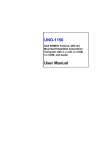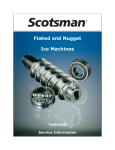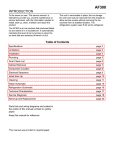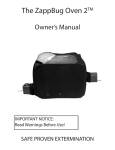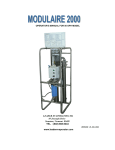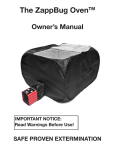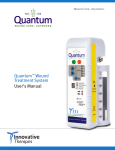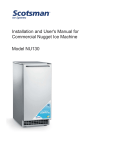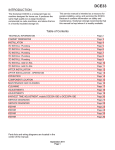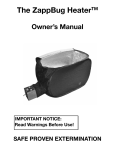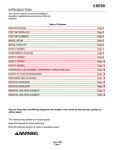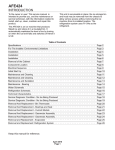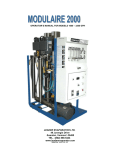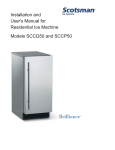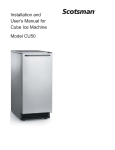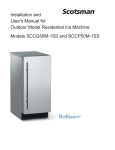Download Installation and User`s Manual for Flaked Ice Machine with Storage
Transcript
Installation and User's Manual for Flaked Ice Machine with Storage Bin Model AFE400 Air or Water Cooled AFE400 INTRODUCTION To the owner or user: This service manual is intended to provide you, and the maintenance or service technician, with the information needed to install, start up, clean, maintain and repair this product. The AFE400 is an ice machine that produces flaked ice and stores it in a insulated bin. It automatically maintains the level of ice by turning on when the ice level falls and switches off when it is full. This unit in serviceable in place; the ice storage bin and hood may be removed from the chassis to allow service access without removing the ice machine from its installed location. The refrigeration system uses R-134a as the refrigerant. Table of Contents Specifications · · · · · · · · · · · · · · · · · · · · · · · · · · · · · · · · · · · · · · · · · · · Page 2 For The Installer: Environmental Limitations · · · · · · · · · · · · · · · · · · · · · · · · · · · Page 3 Installation · · · · · · · · · · · · · · · · · · · · · · · · · · · · · · · · · · · · · · · · · · · · Page 4 Installation: Water and Drain · · · · · · · · · · · · · · · · · · · · · · · · · · · · · · · · · · · Page 5 Installation · · · · · · · · · · · · · · · · · · · · · · · · · · · · · · · · · · · · · · · · · · · · Page 6 Removal of the Cabinet · · · · · · · · · · · · · · · · · · · · · · · · · · · · · · · · · · · · · · Page 7 Initial Start Up · · · · · · · · · · · · · · · · · · · · · · · · · · · · · · · · · · · · · · · · · · · Page 8 Maintenance and Cleaning · · · · · · · · · · · · · · · · · · · · · · · · · · · · · · · · · · · · Page 9 Maintenance and Cleaning · · · · · · · · · · · · · · · · · · · · · · · · · · · · · · · · · · · · Page 10 Maintenance and Sanitation · · · · · · · · · · · · · · · · · · · · · · · · · · · · · · · · · · · Page 11 Maintenance - Bearing · · · · · · · · · · · · · · · · · · · · · · · · · · · · · · · · · · · · · · Page 12 What to Do Before Calling for Service · · · · · · · · · · · · · · · · · · · · · · · · · · · · · · Page 13 Keep this manual for reference. February 2009 Page 1 AFE400 Specifications 14.25 IN The nameplate is located on the back panel. A serial number plate is located behind the right grill, in front of the control box, on the base. SERIAL NUMBER PLATE The unit is equipped with an electrical power cord, but should only be plugged into a circuit dedicated to the ice machine. Model Number Dimensions (w/o) legs HxWxD AFE400A-1 33 x 24 14 x 24 AFE400W-1 same AFE400A-6 33 x 24 14 x 24 Basic Ice Electrical Type Condenser Typical Maximum Type Amps Fuse 115/60/1 same 230/50/1 Air same Air Flake same Flake A scoop and legs (6") are included. February 2009 Page 2 9 same 9 15 same 15 AFE400 For The Installer: Environmental Limitations The ice machine must be installed indoors in a controlled environment. Minimum Maximum Air Temp 0 50 F. 1000F. Water Temp 400F. 1000F. Water Pressure 20 PSI 80 PSI Voltage (60 Hz) 103.5 126.5 Voltage (50 Hz) 207 253 Airflow on air cooled models: AIR OUT Operating the ice machine outside of the above limitations, or outdoors, is potentially damaging to the machine, and it is misuse of the machine. This may void the warranty. Scotsman Ice Systems are designed and manufactured with the highest regard for safety and performance. They meet or exceed the standards of UL, NSF, and other agencies. Scotsman assumes no liability or responsibility of any kind for products manufactured by Scotsman that have been altered in any way, including the use of any part and/or other components not specifically approved by Scotsman. AIR IN · Intake through the right grill. · Exhaust from the left grill. Do not install where this air flow is blocked. The AFE400 has a removable cabinet. When installed, the machine should have some extra clearance (1/8") on the left and right sides so that the cabinet may be easily removed when the machine is in place. Scotsman reserves the right to make design changes and/or improvements at any time. Specifications and design are subject to change without notice. February 2009 Page 3 AFE400 Installation Water The water supply for this ice machine has been in contact with many materials since it fell from the sky as rain. All rain is slightly acidic, and tends to dissolve the materials it comes in contact with. During water’s journey to the ice machine, it has flowed over and through the ground, been picked up by a municipal or private pump, forced through a series of pipes of differing construction and may have been treated by the municipality providing the water. The water supplied to this ice machine will then contain a variety of substances that will likely show up as solids during the ice making process. These solids are similar to those found when water is boiled out of a saucepan. Only the water boils away, and the minerals that were in the water solidify in the pan. During ice making the water is frozen into ice, and many of the minerals stay behind in the ice machine water system. After time the minerals will have to be dissolved by ice machine cleaner, then flushed away during the cleaning process. An ice machine is a food manufacturing plant; it takes a raw material, in this case water, and transforms it into a food product, ice. The purity of the water is very important in obtaining pure ice and in maximizing product life. The water to the ice machine should be filtered. Water filters vary greatly in ability and function. Install one that filters out suspended solids to a dimension of 5 microns or less. The finer the filter the better, but finer filters may plug-up sooner than course ones. It may be necessary to add a course filter ahead of the fine filter to prolong filter life. This ice machine may be installed in the open or under a counter. No clearance is required at the sides or top beyond what’s needed to place the cabinet into position. Air cooled models blow air in and out through the grills at the front. Space is required for utility connections at the back. The ice machine is not designed for outdoor use. It must be installed indoors, in a controlled environment. The air and water temperatures must not exceed rated limits. Electrical power is supplied through a cord connected to the unit. All local codes must be followed. Pre-installation: 1. Inspect the place where the ice machine is to be installed. Check for: · space for the cabinet · water supply, · drain availability · and electrical power supply. No extension cords are allowed. The building drain inlet must be lower than the drain outlet(s) at the back of the ice machine. The water supply must have a hand shut off valve accessible when the unit is installed. 2. Determine the method of installation, is the machine to be installed under the counter? Is the drain in the floor under the machine? Is the water inlet accessible from the top? Have the water tested. Either acidic water or alkaline water will cause corrosion. Dissolved solids cannot be filtered out. Check with a water treatment specialist regarding testing, treatment and filters. February 2009 Page 4 AFE400 Installation: Water and Drain For The Plumber 1. Connect cold potable water to the 3/8" male flare at the top back of the cabinet. A water filter is recommended. Flush the water line prior to connecting to the ice machine. A loop of copper tubing may be used between the ice machine and the water supply. This will allow the ice machine to be pulled out from its installed location without disconnecting the water line. No back-flow preventer is required in the inlet potable water line because provision for that is incorporated in this N.S.F. listed product (the float seat is above the reservoir water level and cannot siphon). 2. Connect a drain tube the drain fitting. If water cooled, the drain tubes must be run separately. The bin drain fitting is 3/4" FPT, and it is plastic. Do not overheat. · Drain tube material must be rigid and meet local code. · Traps in the bin drain line without vents ahead of them will cause poor draining. · The bin drain must be vented if there is a long horizontal run (5’ or more). All drains are gravity, and must have a minimum fall of 1/4" per foot of horizontal run. · Maintain the air gap required by local code between the end of the drain tubes and the building drain receptacle. · Drain tubing should be insulated to prevent condensation from forming on the tubing. 3. Water cooled models have a separate 3/8" FPT fitting for condenser water inlet. Do not filter water to this connection. The condenser drain is 1/2" FPT and does not need a vent. AIR COOLED PLUMBING CONNECTIONS POTABLE WATER INLET BIN DRAIN WATER COOLED PLUMBING FLOOR DRAIN RESERVOIR OVERFLOW DRAIN POTABLE WATER INLET CONDENSER DRAIN CONDENSER INLET February 2009 Page 5 AFE400 Installation For The Electrician This is a cord-connected unit, and must be on a separate single phase power supply. Check the nameplate for the correct voltage. The maximum fuse size for this circuit should be 15 amps, per the nameplate use fuses, or HACR circuit breakers. Follow All Local Codes - THIS UNIT MUST BE GROUNDED. Do not use extension cords and do not disable or by-pass ground plug on electrical plug. After Utility Connections: 1. Level the cabinet, use the leg levelers on the end of the legs to adjust the cabinet height. (Legs should have been installed when the unit was unpacked). 2. Wash the bin and hood. If desired, the interior of the bin could be sanitized. 3. Locate the scoop, wash it and have it available for use when needed. Final Check List 1. Is the ice maker cabinet in a room where ambient temperatures are within the minimum and maximum temperatures specified? 12. Has the owner/user been given the name and telephone number of the authorized Scotsman Service Agency serving that location? 2. Has the water supply been connected? 3. Is the water pressure adequate? 4. Have the water connections been checked for water leaks? 5. Have the drain connections been made? 6. Have the drain connections been checked for leaks? 7. Is the cabinet level? 8. Is the ice machine plugged into an electrical power supply of the correct voltage and is the ice machine the only load on that circuit? 9. Has all of the shipping material been removed from the inside of the cabinet? 10. Has the bin and cabinet been wiped clean and sanitized? 11. Has the Customer Evaluation & Warranty Registration form been filled out? Check for correct model and serial numbers from the nameplate, then mail the completed form to Scotsman. February 2009 Page 6 AFE400 Removal of the Cabinet One of the most useful features of this ice machine is the ability to remove the cabinet from the ice machine without removing the ice machine from its installed position. STEP 2 To Remove: 1. Switch the master switch to OFF. Be certain the ice machine has been switched off. 2. Open the bin door and turn the knobs to unscrew the mounting bolts at the left and right inside of the ice storage bin. Remove the mounting bolts. 3. Pull the hood and door assembly straight out until it can be lifted up. Caution: the door may be free to come out the back of the hood when removed from the cabinet base. STEP 3 4. To remove the cabinet base the hood must be removed first. 5. Remove 4 screws and the two grills at the front of the base. 6. In the area exposed when the grills are removed are two knobs similar to those removed in step 2. Unscrew and remove the two knobs. 7. Locate bin drain. Loosen hose clamp holding drain tube to fitting and pull the drain tube off of the fitting. 8. Lift up the front of the base and rotate the base up and off of the ice machine. The machine is now exposed for service. STEP 5 STEP 8 STEP 6 BIN DRAIN February 2009 Page 7 HOOD AFE400 Initial Start Up After the final check list has been gone through, the ice machine may be started up. 1. Open the water shut off valve and allow the reservoir to fill with water. The ice machine will not operate without 20 pounds of water pressure. Note: The reservoir cannot be seen without removing the hood and cover plate, do not adjust float level unless the float does not shut off or overflows out the drain. 2. Remove two screws and the right grill. 3. Locate the master switch and switch it to ON. 4. On air cooled models the fan motor will begin to turn, and warm air will be discharged from the left front of the ice machine. On water cooled models warm water will begin to flow from the condenser drain. 5. The water temperature in the evaporator will soon drop below freezing and ice will begin to flow out of the chute. The first bits of ice will not be has hard nor dry as it will after about 10 minutes of ice production. 6. Allow the ice machine to operate for about 20 minutes. Then pour clean water into the bin to melt the ice. This will flush out most manufacturing or shipping materials that may have strayed into the water/ice making system. 7. Check the operation of the bin thermostat by placing ice over the sensing tube. A properly operating bin thermostat will open when ice covers the sensing tube. When the bin thermostat opens, the compressor will stop, but the auger motor will continue to operate, pushing out ice that has formed in the evaporator. The bin will fill with ice until the top of the ice pile covers the bin thermostat sensing tube. At that point the lower part of the ice pile will be very close to the bottom edge of the door opening. Note: The thermostat is adjustable to allow for variations in altitude. Rotating the adjustment knob counterclockwise will adjust the thermostat to open and close at warmer temperatures. Adjustment should not be needed unless the altitude is greater than 2,000 ft. After adjustment, place ice on the thermostat tube to check that the machine shuts off at the new setting. 8. Replace all the grill and close the bin door. The ice machine is now ready for automatic operation. February 2009 Page 8 AFE400 Maintenance and Cleaning Cleaning Schedule: · Scrub the outside and inside of the cabinet once a week with soap and water. · Sanitize the bin interior once a month. · Clean the water system and air cooled condenser a minimum of twice per year. If in an area of high mineral concentration in the water supply, clean water system 4 times a year. This ice machine will perform at its best when kept clean. There are two areas to keep clean: The water system including the water reservoir, auger and evaporator surface; and the air cooled condenser filter and the condenser itself. Air Filter (air cooled only): 1. Remove the grill on the right front of the unit. 2. Remove two screws and the bracket holding the filter to the condenser. Note: If the unit has been operated without the filter in place, the fins of the condenser will become fouled with dirt, and must be cleaned. Scotsman recommends that only the surface of the condenser be cleaned with the bin in place. A vacuum cleaner with a soft brush attachment will extract most loose dust stuck to the surface of the condenser fins. If there is any doubt about dirt inside the fins of the condenser, the cabinet should be removed and a qualified service agent should clean the condenser. Water cooled units: The water cooled condenser may, over time and under certain water conditions, become internally restricted by minerals. These will have to be dissolved by acid or the condenser replaced. Only a qualified service agent should attempt this type of service. 3. Pull the filter forward and twist it slightly to pull it though the slot in the front base of the ice machine. Remove Bracket 4. Wash the surface of the filter off with cold water, or, if torn or so dirty it can’t be cleaned, replace with a new filter. Remove Filter 5. Return the filter to its installed position. 6. Replace the bracket removed in step 2. 7. Replace the grill. Do not operate the unit without the filter in place. February 2009 Page 9 AFE400 Maintenance and Cleaning Cleaning Water System: The water system is cleaned by pumping a mixture of water and Scotsman Ice Machine Cleaner through the water reservoir into the evaporator and into the ice storage bin as ice. 15. Pour the cleaning solution into the reservoir until it is full and wait 20 minutes. POURING CLEANING SOLUTION INTO RESERVOIR 1. Locate the master switch, and move it to the OFF position. 2. Empty the bin of ice. 3. Locate knobs holding hood to bin and remove them. 4. Remove hood from ice machine. RESERVOIR 5. Remove the right and left grills. 6. Locate knobs holding bin to chassis and remove. 7. Disconnect drain hose from bin. 8. Lift up on front of bin and rotate bin off of chassis. 9. Remove cover plate over reservoir. 10. Block the float up to shut off water flow. 11. Locate the evaporator drain, unplug it and drain the evaporator. Re-plug the drain. 12. Place the bin back onto the chassis. 13. Reconnect the drain hose to the bin drain. 14. Mix a solution of 1.5 quarts of warm (950F. 1150F.) water and 4 ounces of Scotsman Clear 1 Ice Machine Scale Remover. Scotsman Ice Machine Scale Remover contains acids. These compounds may cause burns. If swallowed, DO NOT induce vomiting. Give large amounts of water or milk. Call Physician immediately. In case of external contact, flush with water. KEEP OUT OF THE REACH OF CHILDREN. 16. Move the master switch to ON, continue to pour cleaning solution into the reservoir until it has all been used. 17. After all of the solution has been poured in, remove the block from under the float. 18. Operate the unit for 15 more minutes. 19. Pour clean water into the bin to melt any ice produced during cleaning. Note: The ice making portion of the water system should be sanitized after cleaning by repeating steps 15-18, except substitute an the following sanitizing solution for the cleaning solution. · Mix a sanitizing solution of 1 ounce of household bleach to 2 gallons of warm (95 oF. 115oF.) water. 20. Replace the grills, cover plate and hood. 21. The unit is now ready for automatic operation or sanitizing of the ice storage bin. April 2009 Page 10 AFE400 Maintenance and Sanitation The interior liner of the bin is in contact with a food grade product: ice. The storage bin must be cleaned regularly to maintain a sanitary environment. Once a week cleaning with soap and water, a hot water rinse and an air dry is a basic procedure. Scale that may form on the plastic liner can be removed by scrubbing the surface with a mixture of Scotsman Ice Machine Cleaner and hot water. Remove any scale prior to cleaning. To Remove Scale: 1. Mix a cleaning solution of 4 ounces of Scotsman Ice Machine Cleaner to 4 pints of hot (950F.-1100F.) water. Scotsman Ice Machine Cleaner contains acids. These compounds may cause burns. If swallowed, DO NOT induce vomiting. Give large amounts of water or milk. Call Physician immediately. In case of external contact, flush with water. KEEP OUT OF THE REACH OF CHILDREN. 2. Using rubber gloves, dip a nylon scouring pad into the cleaning solution and scrub the scale off the liner. 3. After the scale has been removed, rinse all surfaces inside the bin with clean, potable water. To Sanitize the bin interior: The hood must be removed from the storage bin so that the joint between the two can be cleaned and sanitized. Use an approved sanitizer and follow the directions and warnings of that sanitizer or use the following instructions for use of household bleach, if it meets local codes: 1. Mix sanitizing solution of 1 ounce of household bleach to 2 gallons of water. 2. Using clean rubber gloves and a clean cloth, wipe all interior surfaces of ice storage bin, hood and door with sanitizing solution. Be sure and wipe the joint between the hood and bin with the sanitizing solution. Use a clean brush to thoroughly swab all interior surfaces with the sanitizing solution. 3. Reassemble and allow to air dry. Stainless Steel Components Inside Bin The stainless steel parts in the bin also require periodic cleaning. Chemicals in the water supply, such as chlorine, cause brown stains to appear on the surface of the stainless steel parts. 1. General Cleaning - staining is usually removed by washing the parts with ordinary cleaning powder such as Bon-Ami or Copper-Glo and water. After cleaning, rinse with clear water. 2. Water treatment. The chlorine enters the machine from the municipal water supply. It can be removed from the water supply by using a charcoal or activated carbon water filter to treat the water to the ice machine. If staining is severe, filters of this type are recommended. Exterior Cabinet Cleaning: The exterior cabinet may be cleaned by scrubbing with soap and water. Do not use cleaners containing petroleum products. A nylon type brush may be used to scrub stubborn deposits. To remove the hood: 1. Open the storage bin door and locate the knobs at the right and left inside wall. 2. Unscrew and remove the two knobs. 3. Pull the hood assembly and door straight out from the ice machine. Note: the door may be removed from the back of the hood when the hood is off. February 2009 Page 11 AFE400 Maintenance - Bearing Evaporator and Auger Inspection The bearings and water seal should be checked once per year. Ice Breaker and Auger Removal for Inspection 7. After the auger has dried, check condition of the auger’s finish, it should be clean and shiny. If not, scrub with Scotsman ice machine cleaner and a clean brush. 8. Reverse all of the above to reassemble. Note: The auger can’t be pulled out when the unit is installed under the counter. Electrical shock hazard. Electrical shock can cause personal injury. Disconnect power before beginning to service components. 1. Remove the hood, door and ice storage bin. 2. Remove stainless steel cover plate. 3. Remove cover from reservoir, and block the float or shut off the water supply. 4. Locate evaporator drain and drain the evaporator/reservoir. 5. Remove sealing cap and check the top bearing surface for water, rust, or wear. replace it if required. Sealing Cap 6. Attach removal tool and lift auger from evaporator. February 2009 Page 12 AFE400 What to Do Before Calling for Service If the machine is off, not making ice: 1. Check the water supply to the ice machine. The machine is designed to shut off f there is no water to it. Check the water filters (if there are any). 2. Check the power supply to the machine. Reset the breaker if it is tripped. 3. If both water and power have been checked and are available, try switching the power Off for an hour, then reconnect power. The machine should restart. If this procedure restarts the machine, service should be called the next time the machine stops. February 2009 Page 13 SCOTSMAN ICE SYSTEMS 775 Corporate Woods Parkway, Vernon Hills, IL 60061 800-533-6006 www.scotsman-ice.com 17-3289 -01


















